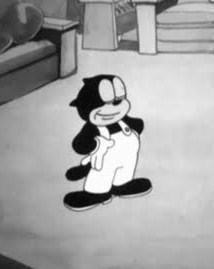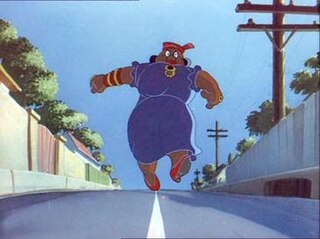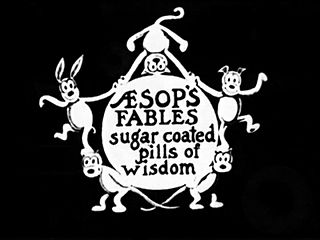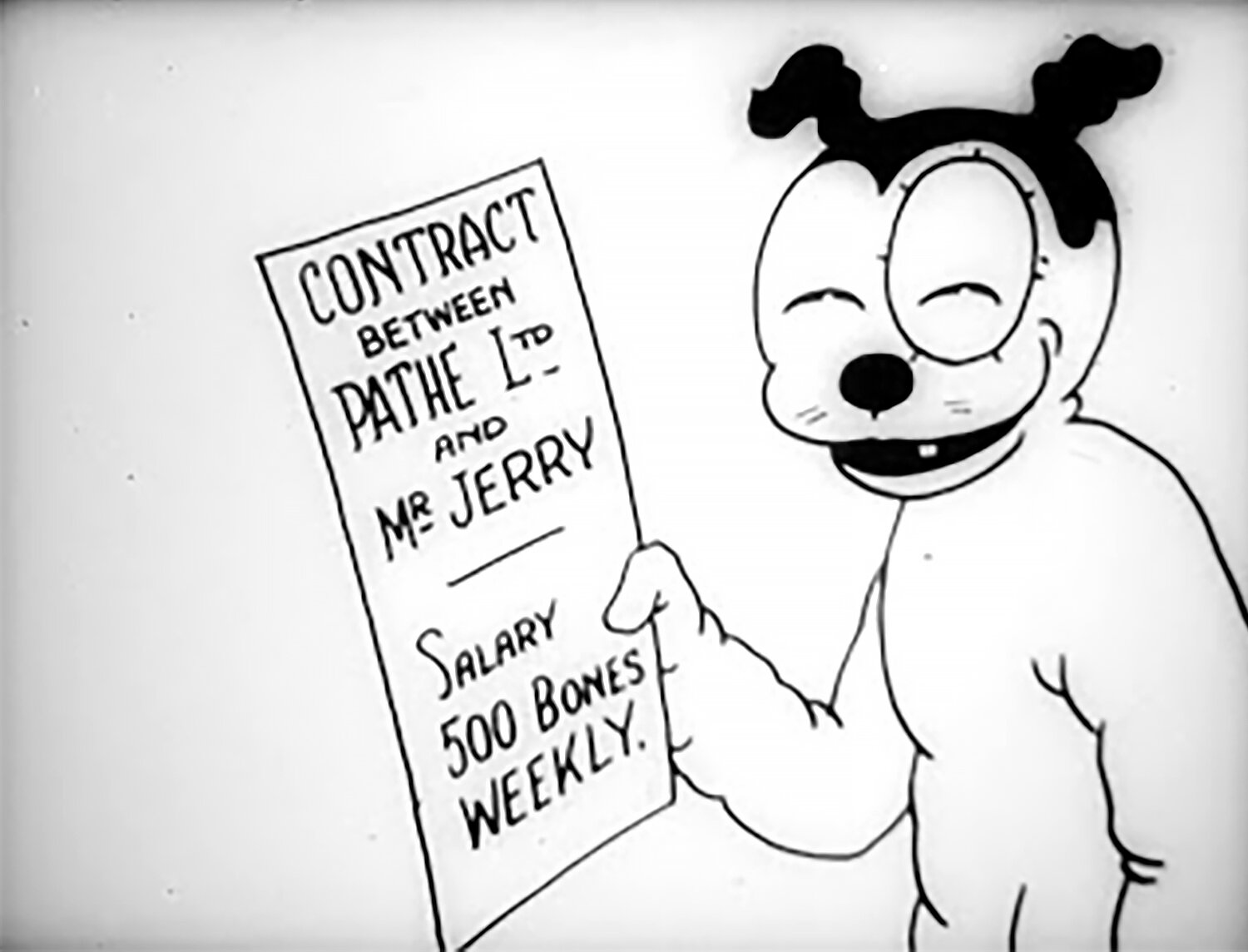
Merrie Melodies is an American animated comedy short film series distributed by Warner Bros. Pictures. It is the companion series to Looney Tunes, and featured many of the same characters as the former series. It originally ran from August 2, 1931, to September 20, 1969, during the golden age of American animation, though it had been revived in 1979, with new shorts sporadically released until June 13, 1997. Originally, Merrie Melodies placed emphasis on one-shot color films in comparison to the black and white Looney Tunes films. After Bugs Bunny became the breakout character of Merrie Melodies and Looney Tunes transitioned to color production in the early 1940s, the two series gradually lost their distinctions and shorts were assigned to each series randomly.
Tom and Jerry is an American animated media franchise and series of comedy short films created in 1940 by William Hanna and Joseph Barbera. Best known for its 161 theatrical short films by Metro-Goldwyn-Mayer, the series centers on the rivalry between the titular characters of a cat named Tom and a mouse named Jerry. Many shorts also feature several recurring characters.

Beans the Cat is an animated cartoon character in the Warner Bros. Cartoons series of cartoons from 1935–1936. Beans was the third Warner Bros cartoon character star after Bosko and Buddy. He is voiced by Billy Bletcher and occasionally by Tommy Bond. He was created by director Friz Freleng. The character was featured in nine cartoons made in 1935 and 1936.

Bonzo the Dog is a fictional cartoon character first created in 1922 by British comic strip artist George Studdy. The pup quickly rose to popularity in the 1920s. He starred in one of the world's first cartoons, became an inspiration for mass-marketed merchandise, and became a favourite among children and adults.

Marie Ault was a British character actress of stage and film.

Mammy Two Shoes is a fictional character in MGM's Tom and Jerry cartoons. She is a middle-aged African American woman who is the housemaid in the house which Tom and Jerry reside. But the fact that she has her own bedroom in the short Sleepy-Time Tom (1951) raises the possibility of her being the owner of the house, as no other human is present in the house in shorts she appears. She would scold and discipline Tom whenever she believed he was misbehaving; Jerry would sometimes be the cause of Tom's getting in trouble.

Henry William George Lupino professionally Lupino Lane, was an English actor and theatre manager, and a member of the famous Lupino family, which eventually included his cousin, the screenwriter/director/actress Ida Lupino. Lane started out as a child performer, known as 'Little Nipper', and went on to appear in a wide range of theatrical, music hall and film performances. Increasingly celebrated for his silent comedy short subjects, he is best known in the United Kingdom for playing Bill Snibson in the play and film Me and My Girl, which popularized the song and dance routine "The Lambeth Walk".

Aesop's Fables is a series of animated short subjects, created by American cartoonist Paul Terry. Produced from 1921 to 1933, the series includes The Window Washers (1925), Scrambled Eggs (1926), Small Town Sheriff (1927), Dinner Time (1928), and Gypped in Egypt (1930). Dinner Time is the first cartoon with a synchronized soundtrack ever released to the public. The series provided inspiration to Walt Disney to found the Laugh-O-Gram Studio in Kansas City, Missouri, where he created Mickey Mouse.

The Metro-Goldwyn-Mayer cartoon studio was an American animation studio operated by Metro-Goldwyn-Mayer (MGM) during the Golden Age of American animation. Active from 1937 until 1957, the studio was responsible for producing animated shorts to accompany MGM feature films in Loew's Theaters, which included popular cartoon characters Tom, Jerry, Droopy, Butch, Spike, Tyke, and Barney Bear.

Spike and Tyke are fictional characters from the Tom and Jerry animated film series, created by William Hanna and Joseph Barbera. Spike is portrayed as an English Bulldog, who is generally amiable and friendly, and a loving father to his son Tyke in several episodes. However, Spike's character also has a very stern, and fierce side, for occasions such as when he is defending his son Tyke.

Otis Harlan was an American actor and comedian. He voiced Happy, one of the Seven Dwarfs in the Disney animated film Snow White and the Seven Dwarfs. This made him the earliest born actor to feature in a Disney film and one of the earliest known American voice actors.
Clito "Clyde" Geronimi, known as Gerry, was an American animation director. He is best known for his work at Walt Disney Productions.
James Patton "Jack" King was an American animator and short film director best known for his work at Walt Disney Productions.
United Kingdom Animation began at the very origins of the art form in the late 19th century. British animation has been strengthened by an influx of émigrés to the UK; renowned animators such as Lotte Reiniger (Germany), John Halas (Hungary), George Dunning and Richard Williams (Canada), Terry Gilliam and Tim Burton have all worked in the UK at various stages of their careers. Notable full-length animated features to be produced in the UK include Animal Farm (1954), Yellow Submarine (1968), Watership Down (1978), and Wallace & Gromit: The Curse of the Were-Rabbit (2005).
Cecil Hays Surry was a cartoonist at various film studios in the Golden Age of Animation.
Jerry is a given name, usually used for males. It is of Old English origin, and sometimes can be spelled Gerry, Gerrie, Geri,Jery, Jere, Jerrie, or Jeri. It is a diminutive form (hypocorism) of George, Gerald, Gerard, Geraldine, Jared, Jeremy, Jeremiah, Jermaine, or Jerome.

Jerry the Tyke also known as Jerry the Troublesome Tyke is a cartoon dog created during the silent film era. Created by Cardiff-based animator Sid Griffiths, and shown throughout British cinemas as part of Pathé Pictorial's screen news-magazines, Jerry the Tyke was the first animated series to be made in Wales.
Woolf & Freedman Film Service was a UK film distributor which was founded by film producer C. M. Woolf, and which operated from 1919 to 1934. The company distributed more than 140 films over a 15-year period. In 1935, Woolf formed a new company, General Film Distributors.










